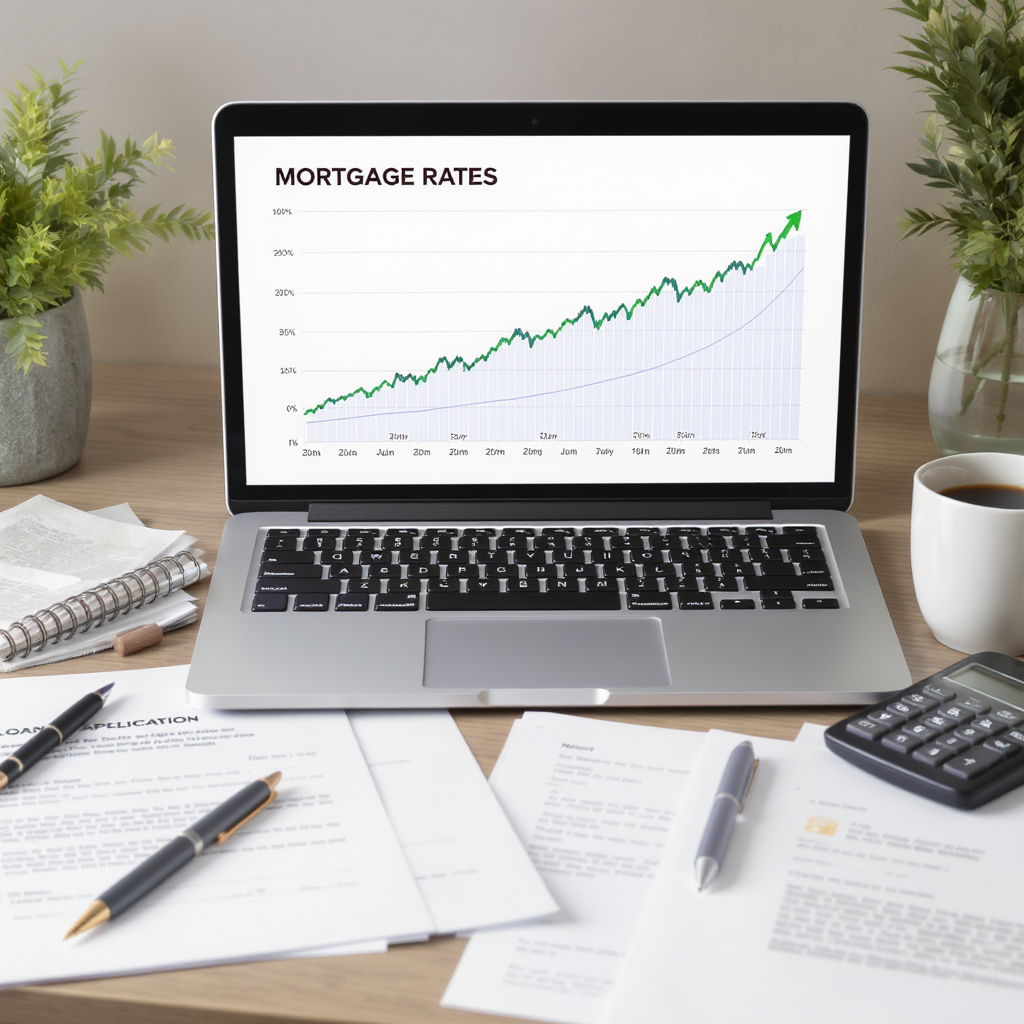How to Lock in Low Mortgage Rates in a Rising Market – Simple Steps You Can Take Today

Have you ever found yourself staring at mortgage rate charts, feeling like the numbers are slipping further out of reach just as you’re ready to buy? It’s a frustrating dance—rates inch up, and suddenly the dream home seems a bit more distant. I remember the unsettling moment when I first realized that waiting too long could cost me thousands more in interest. That feeling sparked a deeper curiosity—how exactly can someone lock in a low mortgage rate when the market seems determined to rise?
The reality is, mortgage rates aren’t just numbers; they’re signals influenced by a complex mix of economic factors, market sentiments, and lender strategies. Right now, as of mid-2025, we’re seeing rates hover around 7% for a 30-year fixed mortgage. Experts suggest a possible dip to about 6.5% by year’s end, but that’s hardly a guarantee. So, what can a prospective homeowner or investor do to avoid getting caught in this upward tide?
Interestingly, some buyers have started exploring “assumable mortgages,” a bit of a hidden gem where you take over the seller’s existing loan with its potentially lower rate. Yet, these opportunities are rare and come with their own hurdles. More commonly, lenders offer something called a “rate lock,” which guarantees your interest rate for a set period—usually 30 to 60 days—while your loan is processed. It’s like putting a hold on that rate, shielding you from sudden increases.
Then there’s the tactic of purchasing discount points—paying a bit upfront to chip away at your interest rate. Each point might cost you 1% of the loan but can reduce your rate by around 0.25%. It’s a trade-off that can make sense if you plan to stay in the home long-term.
Adjustable-rate mortgages (ARMs) also enter the conversation here. They start with lower rates, offering short-term relief, but they come with the risk of rising rates down the road. It’s a gamble that some are willing to take, depending on their financial horizon.
A larger down payment can also be a powerful lever. By reducing the loan-to-value ratio, lenders see you as less risky, which often translates into better rates. But of course, saving that extra chunk of cash is easier said than done.
The key, it seems, is preparation and vigilance. Shopping around among banks, credit unions, and online lenders can uncover better deals—you’d be surprised how much variance there is. Staying informed about economic indicators and Federal Reserve moves helps you anticipate rate trends, making your timing sharper.
And perhaps most importantly, consulting with seasoned loan officers or mortgage brokers can tailor the approach to your unique situation. They bring a perspective that raw numbers can’t capture.
So, as we stand amidst these shifting sands of mortgage rates, what’s your next move? Will you seize the moment with a rate lock, venture into the territory of discount points, or perhaps consider an ARM? Or is the better strategy to wait and watch the market’s subtle signals? There’s no one-size-fits-all answer here—only a series of thoughtful steps we can take together to navigate uncertainty.
Could locking in a low mortgage rate in a rising market be less about timing and more about strategy? As we explore these questions, one thing becomes clear: the journey to securing favorable mortgage terms is as much about proactive planning as it is about reacting to numbers on a screen. Let’s continue unpacking these strategies and figure out what might work best for you.
Navigating the Maze: How to Lock in Low Mortgage Rates Amidst Rising Trends
I still recall the unease of watching mortgage rates inch upward just as I was preparing to buy my first home. That creeping feeling—like watching a balloon slowly deflate your hopes—made me realize that understanding the how behind locking in a good mortgage rate was crucial. It’s not merely about catching a falling number; it’s about weaving through a landscape shaped by economic forces, lender policies, and your financial readiness.
Why Timing Alone Isn’t Enough
We often think, “If only I buy at the right moment, the rate will be low.” But recent data suggests it’s more nuanced. Currently, 30-year fixed mortgages hover near 7%, with some experts predicting a slight dip to around 6.5% by the end of the year. But what if rates suddenly spike during your loan approval process? That’s where the concept of a rate lock comes into play—a safety net many overlook until it’s too late.
Step 1: Understand and Use Rate Locks Wisely
Rate locks are agreements with lenders to freeze your interest rate for a set period, typically 30 to 60 days. Think of it as pressing pause on the rising tide of rates while your mortgage application is processed. However, this isn’t automatic. You’ll want to:
- Ask your lender about lock options early. Some lenders might offer extended locks for a fee, which can be worth it if you anticipate delays.
- Know the lock period carefully. If your loan closes after the lock expires, you might face a higher rate.
By proactively negotiating a rate lock, you reduce the risk of last-minute surprises.
Step 2: Consider Discount Points—When Paying More Now Saves Later
This strategy intrigued me when I first encountered it. Discount points are upfront fees—typically 1% of your loan amount per point—that lower your interest rate by roughly 0.25% each. For example, on a $300,000 loan, one point costs $3,000 but could reduce your monthly payment noticeably.
Is this worth it? It depends:
- Plan to stay in your home long-term? Paying points can save money over the years.
- Short-term stay? The upfront cost might not pay off.
Recent guides, like those from The Mortgage Reports, emphasize running the math: calculate your break-even point to see if the upfront cost makes financial sense.
Step 3: Explore Adjustable-Rate Mortgages (ARMs) with Caution
ARMs start with lower rates than fixed mortgages, offering immediate savings in a rising rate environment. But—and here’s the catch—rates adjust after the initial fixed period, potentially climbing higher than current fixed rates.
Some buyers find ARMs appealing if they plan to sell or refinance before adjustments kick in. But this is a gamble:
- Are you confident about your timeline?
- Will you be able to handle higher payments if rates climb?
Experts at CBS News warn that ARMs can be a double-edged sword—short-term relief but possible long-term risk.
Step 4: Boost Your Down Payment to Unlock Better Rates
It’s tempting to scrape together the minimum down payment, but increasing that amount can do wonders. A bigger down payment lowers your loan-to-value ratio, signaling to lenders that you’re less of a risk.
This often translates to:
- Lower interest rates
- Reduced mortgage insurance premiums
However, accumulating a larger down payment isn’t always easy. It requires disciplined saving or creative strategies—like tapping into retirement funds or gifts from family, though these come with their own considerations.
Step 5: Shop Around—Don’t Settle for the First Offer
One lesson I learned the hard way is that mortgage rates vary significantly among lenders. Banks, credit unions, online lenders—they all compete for your business.
To maximize your chances:
- Get quotes from multiple lenders. Even a 0.25% difference can mean thousands saved.
- Ask about fees, points, and lock policies. Sometimes a seemingly low rate comes with high upfront costs.
Resources like SCORE.org suggest dedicating time to compare and negotiate—it can pay off.
Step 6: Stay Informed About Market Signals
Mortgage rates don’t move randomly. They’re influenced by Federal Reserve decisions, inflation reports, and broader economic trends. While predicting exact movements is challenging, staying informed puts you in the driver’s seat.
- Follow trusted financial news sources.
- Consult mortgage professionals who track these indicators.
This vigilance helps you decide when to lock in or float your rate.
Step 7: Engage Professionals Who Know the Terrain
Mortgage brokers and seasoned loan officers can be invaluable allies. They have access to diverse loan products and understand the nuances of timing, lender requirements, and current market conditions.
Their insights can:
- Tailor options to your financial profile
- Help you navigate complex products like assumable mortgages, which, while rare and complex, might save you money
Facing Challenges Along the Way
Of course, none of this is without hurdles:
- Rate locks can come with fees.
- Discount points require upfront capital.
- ARMs carry inherent risks.
- Larger down payments demand patience and sacrifice.
And yet, isn’t it compelling to think that through informed choices and strategic planning, we might wrestle some certainty out of market unpredictability?
So, where does this leave us? Are we merely gamblers at a table of shifting rates, or can we be strategists who prepare, adapt, and act with insight? Maybe the question isn’t just how to lock in low mortgage rates, but how to embrace the complexity and uncertainty as part of the journey to homeownership.
What strategies resonate with you? Would you lean toward the safety of a fixed rate lock, the calculated risk of an ARM, or perhaps the nuanced path of discount points and down payments? The conversation is just beginning, and I’d be curious to hear your thoughts as we continue exploring this together.

Reflecting on the maze of strategies to lock in low mortgage rates amid a rising market reveals a landscape where timing meets thoughtful preparation. We’ve journeyed through options like rate locks that pause the creeping tide of increasing rates, discount points that ask for upfront commitment in exchange for long-term savings, and the intriguing yet risky terrain of adjustable-rate mortgages. Beyond these, the power of a larger down payment and the crucial habit of shopping around among lenders stand out as anchors in this sea of uncertainty. Yet, the true insight may lie not just in the tactics themselves, but in embracing a mindset of vigilance, informed decision-making, and personalized guidance.
This exploration equips you with more than just knowledge—it offers a toolkit to approach mortgage rates with agency rather than apprehension. By understanding these methods and weighing their implications against your unique situation, you gain a clearer path through what once seemed like an unpredictable market.
So, what can you do now? Start by reaching out to multiple lenders to explore rate lock options and request detailed quotes that include fees and points. Calculate whether purchasing discount points aligns with your long-term plans. Consider if an ARM fits your financial horizon or if a larger down payment is within reach through careful saving strategies. Most importantly, engage with mortgage professionals who can tailor advice to your needs and help interpret market signals as they unfold.
Looking ahead, as economic factors continue to influence mortgage rates, staying informed and adaptable will be your greatest allies. The landscape of home financing is evolving, and those who combine strategy with curiosity stand to navigate it most successfully.
Ultimately, securing a favorable mortgage rate in a rising market is less about predicting every twist and more about crafting a well-thought-out approach that fits your life. What steps will you take to turn these insights into action? The journey toward your homeownership goals continues—let’s keep exploring it together.





